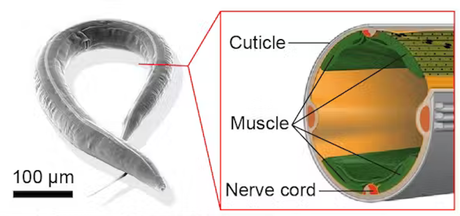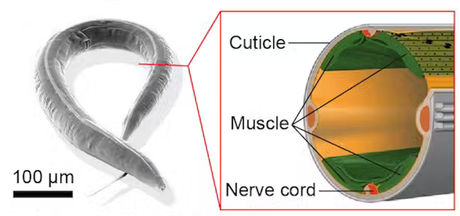Scientists have been trying to build snake-like robots without limbs for decades. These robots could come in handy in search and rescue situations, navigating through collapsed buildings to find and help survivors.
With their sleek, flexible bodies, limbless robots could easily move through confined and cluttered spaces, such as debris fields, where walking or wheeled robots and human rescuers tend to fail.
But even the most advanced limbless robots have not yet come close to the agility and versatility of worms and snakes in difficult terrain. Even the small nematode worm Caenorhabditis elegans which has a relatively simple nervous system, can navigate difficult physical environments.
As part of a team of roboticists and physicists, we wanted to investigate this discrepancy in performance. But instead of looking to neuroscience for an answer, we turned to biomechanics.
We wanted to build a robot model that powered its body using a mechanism similar to the way worms and snakes power their movement.
Wave resources and mechanical intelligence
Over thousands of years, organisms have developed complex nervous systems that allow them to sense their physical environment, process this information, and perform precise body movements to avoid obstacles.
In robotics, engineers design algorithms that take information from sensors on the robot's body - a kind of robotic nervous system - and use that information to decide how to move. These algorithms and systems are usually complex.
Our team wanted to come up with a way to simplify these systems by emphasizing mechanically controlled approaches to dealing with obstacles that don't require sensors or computation. To do that, we turned to examples from biology.
Animals don't rely solely on their neurons - brain cells and peripheral nerves - to control movements. They also use the physical properties of their bodies - for example the elasticity of their muscles - to help them respond spontaneously to their environment, before their neurons even have a chance to respond.
The story continues
While computational systems are governed by the laws of mathematics, mechanical systems are governed by physics. To accomplish the same task, scientists can design an algorithm or carefully design a physical system.
For example, robots and limbless animals move through the world by bending parts of their bodies left and right, a type of movement called undulation. If they collide with an obstacle, they must turn away and go around it by bending more to one side than the other.
Scientists could achieve this with a robot by attaching sensors to its head or body. They could then design an algorithm that tells the robot to turn away or circle around the obstacle when it "feels" a large enough force on its head or body.
Alternatively, scientists could carefully select the robot's materials and the arrangement and strength of its motors so that collisions would spontaneously produce a body shape that led to a turn. This robot would have what scientists call 'mechanical intelligence'.
If scientists like us can understand how organisms' bodies respond mechanically to contact with objects in their environment, we can design better robots that can overcome obstacles without having to program complex algorithms.
If you compare a diverse set of wavy organisms to the ever-expanding zoo of robotic snakes, one difference between the robots and biological waves stands out. Nearly all wavy robots bend their bodies using a series of connected segments with motors at each joint. But that's not how living organisms bend.
In contrast, all limbless organisms, from large snakes to the simple, microscopic nematodes, achieve flexion not through a single rotational joint motor system, but instead through two muscle bands on either side of the body. To an engineer, this design seems counterintuitive. Why control something with two muscles or motors when you can do the work?


To get to the bottom of this question, our team built a new robot called MILLR, a mechanically intelligent robot without limbs, inspired by the two muscular bands of snakes and worms. MILLR has two independently controllable cables that pull each joint bilaterally to the left and right.
We found that this method allows the robot to spontaneously move around obstacles without having to sense the environment and actively change its body position to suit the environment.
Building a mechanically intelligent robot
Rather than mimicking the detailed muscular anatomy of a given organism, MILLR applies forces to both sides of the body by coiling and unwinding a cable.
In this way, it mirrors the muscle activation methods that snakes and nematodes use, with the left and right sides taking turns activating. This activation mode pulls the body to one side or the other by tensing on one side while the other side relaxes and is passively pulled.


By changing the amount of slack in the cables, we can achieve different degrees of body stiffness. When the robot collides with an obstacle, depending on the cable tension, it selectively maintains its shape or bends under the force of the obstacle.
We found that when the robot actively bent to one side and experienced a force in the same direction, the body complied with the force and bent further. In contrast, if the robot experienced a force acting against the curve, it would remain stiff and push itself away from the obstacle.
Due to the stress pattern along the body, head-on collisions, which would normally cause the robot to stop moving or jam itself, naturally led to a detour around the obstacle. The robot was able to push itself forward consistently.
MILLR testing
To investigate the benefits of mechanical intelligence, we built small obstacle courses and sent nematode worms through them to see how well they performed. We sent MILLR a similar course and compared the results.
MILLR moved through its orbit about as effectively as the real worms. We noticed that the worms made the same kind of body movements when they bumped into obstacles as MILLR.
The principles of mechanical intelligence could extend beyond the domain of nematodes. Future research could look at designing robots based on a variety of other types of organisms for applications ranging from search and rescue to exploring other planets.
This article is republished from The Conversation, a nonprofit, independent news organization providing facts and analysis to help you understand our complex world.It was written by: Tianyu Wang, Georgia Institute of Technology and Christopher Pierce, Georgia Institute of Technology.
Read more: This work was supported by the National Science Foundation Physics of Living Systems Student Research Network, NSF-Simons Southeast Center for Mathematics and Biology, Army Research Office Grant, and the Dunn Family Professorship.